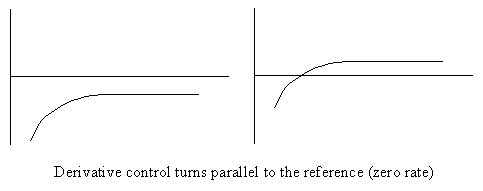
A derivative is the rate of change of a signal. For example, if you are traveling to a town 10 miles down the road; and you are driving there at 65 miles per hour (maybe 70 if you can get away with it!). Your error is 10 miles, and your derivative of that error is 65 miles/hour. The derivative (or what Iím probably going to call rate most of the time) tells you how fast your are approaching or departing from your reference.

The important signal here is the rate signal that leaves the "rate taker" and is multiplied by Krate to provide the output. The above drawing is one way that the signal can be generated. If your robot is following a non-varying target (such as the wall), it isn't necessary to subtract the measured value from the reference. Since the reference is not changing, the rate of the measured signal is the same as the rate of the error.
Another option is if you have a sensor that measures the rate directly and you don't have to use a rate taker.
To get back to the robot. If you a trying to follow a wall at a distance of 24 inches, the rate signal might say that the robot is approaching the wall at 2 inches per second. Since the goal is to travel parallel to the wall, we want the rate to be zero. Hence, this rate signal is another type of error signal. If the robot is moving closer to the wall, we want the steering to turn away from the wall. If the robot is moving away from the wall , we want to steer back towards the wall.
In block diagram form, this is similar to the proportional control shown previously.

This says that the steering will turn two degrees for each inch per second that the robot is deviating from a path parallel to the wall. Note that the gain is negative. This causes the robot to turn back toward a path parallel to the wall. And clearly, as the rate goes to zero (meaning parallel), the steering will go to zero also, so it will tend to stay parallel.
The equation for this would be:
Steering command = Krate * rate
The following figure shows the effect of this control on a robot which starts out pointed toward a reference line. The robot turns to be parallel to the line (zero rate), but doesnít care if it is on either side of the line or even if it passes through the line.

Another characteristic of the rate control is that it is much more stable than the proportional gain since the robot must be parallel to the wall when the steering is zero. The proportional gain was unstable with car type steering since the steering went to zero when the robot was the right distance from the wall, but there was not guarantee (or even likelihood) that robot would be pointed in the right direction.
This equation provides good guidance to drive parallel to the wall but doesnít really care if it is at the desired distance.
So, now for the good news. These two equations (proportional and derivative) can be combined to provide a stable control which will track the wall at the desired distance.
Return to the Control law menu to select the next subject